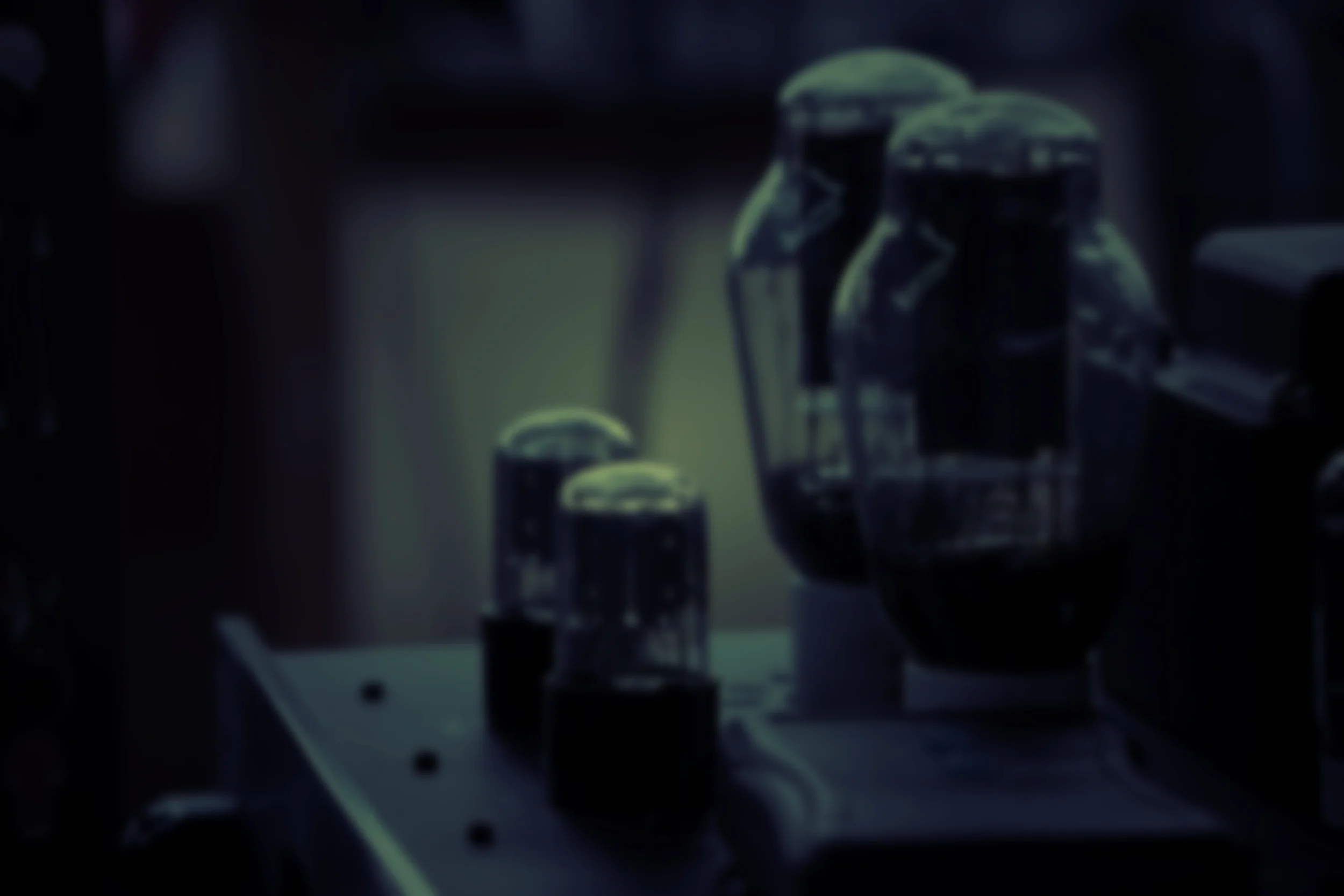PREAMPLIFIER WITH REMOTE CONTROL
jump to: DETAILS SPECIFICATIONS REVIEWS DOWNLOADS
jump to: DETAILS SPECIFICATIONS REVIEWS DOWNLOADS
We combine the historic 300B with another classic, the large octal based 6SL7GT, for the input stage- all triodes running in pure Class A operation. To complement this 'retro' feel, we implemented vacuum tube rectification and regulation in the power supply along with plenty of capacity. We also developed an additional (and innovative) ripple rejection circuit to filter out power supply noise making this an incredibly low-noise preamplifier- especially critical for headphone users.
Complementing this lovely and rich sounding line-driver is the ALPS audiophile volume control, gold plated RCA connectors, high purity silver wire, mil-spec printed circuit boards with extra thick copper and plating, and custom designed output transformers which we wind right here in our own magnetics department. It all adds up...
For 2002, we returned to our classic and elegant "Manley-Blue" pewter grey color and the chassis was reworked to accommodate a few updates we had in mind – and in 2022, we added Black and Silver faceplates as custom-order options.
Whether you use headphones or loudspeakers this preamp will deliver the goods and spoil you for any other preamplifier.
Notes for current version not covered in the manual:
The transformer switch puts the output transformer in or out of circuit. You HAVE TO have it switched to "IN" to use the headphone jacks. It is recommended, in the spirit of "less is more", to switch to "OUT" when using the main line outputs.
The SUB out is a post-volume control output which can be used to drive a powered subwoofer unit so that the level of the subwoofer follows the volume level of the preamplifier.
Inputs: 5 stereo pair unbalanced RCA jacks
Outputs: 2 stereo pairs MAIN out same as SUB out unbalanced RCA jacks
RECORD output: 1 stereo pair pre-volume control unbalanced RCA jacks
HEADPHONE Outs: 2 front panel 1/4" headphone jacks
Optimized headphone impedance switching: 30-400 Ohms to 300-4000 Ohms
MUTE: Selecting HEADPHONE operation mutes LlNE outputs
Output Vacuum Tubes: 2 x 300B Electro-Harmonix
Input Tubes: 2 x 6SL7 Sovtek
Rectifier Tubes: 2 x 5AR4 Ruby
Regulator Tubes: 2 x OD3
Gain: factory set at 12 dB at max Volume
Internal Variable Feedback: 8.5 dB of global NFB is used @ 12 dB of gain, adjustable trim -1.7dB to +1dB
Noise Floor: typically -70 dB (1 Hz - 100 KHz)
S/N Ratio: typically 105 dB (A WGT, 20 Hz - 20 KHz)
Frequency Response: 5 Hz to 50 KHz 1dB
Channel-to-Channel Separation (L to R): @1KHz 48 dB; @10KHz 35 dB; @20KHz 34 dB
Channel-to-Channel Separation (R to L): @1KHz 50 dB; @10KHz 40 dB; @20KHz 37 dB
THD: 0.08 % @ 1KHz at 1V rms out
Distortion THD+N: -80 dB (.01 %) zero "crossover" distortion, mostly 2nd harmonic
Input Sensitivity: 250mV (-9.8dBu) yields 1V out
Input Impedance: 100 kOhm Noble volume control
Maximum Input Level: 5.5dBu or 1.459 Vrms @ 1KHz, volume control at maximum
Output Impedance (LINE STAGE): 100 Ohms
Maximum Output Level: 17.2dBu or 5.636 Vrms @ 1KHz, volume control at maximum
Output Power (100 Ohm Headphones): 1W (10 V RMS) (28 V P-P)
Output Power (600 Ohm Headphones): 1W( 25 V RMS) (70 V P-P)
Power Consumption: 170 Watts (1.4 A @ 120VAC)
Operating Mains Voltage: Factory set for 100V, 120V or 220-240VAC operation for original destination country's mains voltage.
Operating Mains Voltage: changeable with power transformer re-wiring and fuse value change.
Mains Voltage Frequency: 50~ 60Hz
Mains Fuse Value: 3A SLO-BLO (100, 120VAC operation), 1.5A SLO-BLO (220-240VAC operation)
Dimensions: W=19" x L=13"
Top Deck Height: 4"
Transformer Height: 3 1/2"
Suggested shelf height minimum: 10" (depending on height of 300B tube)
Shipping Weight: 28 Ibs.
- Christiaan Punter, Hi-Fi Advice, December 2020
- Blair T. Rogers, The Inner Ear Report
- Dr. Harvey "Gizmo" Rosenberg
- Jason Victor Serinus, Home Theater Hifi, June 2004
- JayTea, Amp/Preamp Asylum, January 2007
- WEIXIN (Chinese)
FAQ #1: I want to roll tubes! What can I do with the rectifier tubes?
Answer: In the original design 300B preamp in the 1990s, we used a Chinese 5AR4 which rarely gave problems; how reliable these tubes are now and how they would work in the latest power supply configuration is something we haven't revisited. We switched from the original Russian 5AR4 at some point as these proved unreliable, and sometimes if they shorted would cause an internal part to fail. The 5U4 has a little higher ratings and is generally more rugged construction. The difference in plate voltage on the tubes with a 5U4 vs 5AR4 is considerably less than 10%; whether you can hear this difference or not is something we won’t comment on, but in actual measurements of the unit, there isn’t any discernible difference. GZ34 rectifiers work fine also. 274B is very similar. 5AR4/GZ34/U77 are internally constructed differently than the other group, but they will work also. The GZ37 and U52 appear to be close to the spec of a 5U4/5AR4 but draw twice the amount of current on the heaters. The 422A and 596 do not show up in our database. We have no experience using any of these other tubes other than what we have shipped our production out with. Impossible for us to say what tubes are best for one of these, 5AR4, 5R4, and 5U4 we know about because we have used them in production.
FAQ #1a: And the Sophia 274B rectifiers? May I use those?
The 274B rigid plate should work in the preamp; its ratings, although not as high as for a 5AR4 or 5U4GB, should not be taxed in these. The reason we would not recommend the mesh plate is the low current capability (90ma); while this may be acceptable once the unit is warmed up, the values of the filter capacitors we use are considerably higher than what Sophia recommends (10uf), and they also recommend a choke-input filter (we use a capacitor-input filter which will lower the current capability of the tube). Another thing to consider is the different construction on the tube; a 5AR4 is an indirectly-heated cathode which warms up very slowly, and the 274B (or a 5U4) is directly heated, warms up very quickly, and will be harder on the 300B output tubes. How much this will affect their life is impossible to say as we have never done any testing on the 274B.
FAQ #1b: What about the heater current? 5AR4 rectifying tubes have a heater current of 1.9 amps. Can I convert the rectifier tubes to 5U4GB which have a 3 amps heater current? Will the power transformer be too overloaded and overheated?
Yes, we looked into this before, according to the transformer datasheet is should be OK.
FAQ#2: What about those solid-state rectifier plugins?
Answer: this unit was designed around the vacuum tube diodes. Two potential problems with plugging in solid-state replacements: 1) higher B+ voltage, 2) instant warmup. The output tubes and the rest of the circuitry will get hit with full high voltage before they are warmed up, which may not be a problem with a preamp but is of concern for power amps. Some output tubes (like 300B’s) are expensive. Also, since the other tubes aren’t drawing any current, the high voltage supply may go over-voltage for some of the capacitors until the tubes warm up. To be honest we haven't tried the solid-state plugins as we designed this unit for tube rectification. Probably most of those issues could be mitigated with a few resistors and a few hours of engineering work.
FAQ #3: Consultation is required on the possibility of using 300b-mesh tubes in the Manley 300b preamplifier. I read that the plate dissipation of the 300b tubes in this preamp is 28 watts. For 300b-mesh lamps, the power dissipated at the anode is recommended not to exceed 22 watts. Is it so? Is it possible to use such tubes in this preamplifier? Are there any restrictions?
Answer: Yes, the 28 watts dissipation is going to be over the 22 watt ratings of the mesh plate tubes. I wouldn't recommend this.
FAQ #4: The 300B tubes won’t light up and the fuse is blowing. Help!
It has happened to all of us. Pull those 300B tubes back out of the sockets. Note that there are two skinny pins and two fatter diameter pins on the base of the 300B tubes. Look at the sockets. You see there are two smaller diameter holes and two larger diameter holes. See? Be sure to orientate the 300B tubes so that the small pins are in the small holes and the big pins are in the big holes.
FAQ #5: My remote is not working. Send me a new one.
All remotes are paired up when they ship out. However, if at some point, if both UP and DOWN buttons get pressed at the same time, it will un-pair the remote and it will need to be re-paired. Follow the pairing procedure in your REMORA REMOTE manual to mate it up again.
FAQ#6: I read that some buyers of the 300b preamp didn't like the volumne control and you built their preamps with a different volume control, so do you offer different volume controls and why did they have them changed?
Are you talking about this post in 2007? We currently use smooth (non-detented) motorized potentiometers for all of our units that use the REMORA RF Remote Volume Control system. The product that the writer reviewed was the prior version 300B Preamplifier without the motorized volume REMORA remote control system and different potentiometers were used both with and without mechanical detents.
FAQ#7: My preamplifier is not sitting level. The chassis wobbles on its feet.
All of these chassis are checked on a granite calibrated flat surface before shipping. However, Sometimes the chassis gets tweaked in shipping or otherwise. Sometimes you can loosen the bottom cover and try to get the chassis tweaked back straight again. You could also try performing like a chiropractic procedure in order to tweak back the chassis by removing the tubes and holding the chassis with your hands and using your knee to give it a press. I know that sounds primitive, but it can totally work. One can try to get inside the chassis and loosen and try to move a foot a little and retighten it. Sometimes you can just shim a foot. I usually use coins under my spikey feet! Other people prefer the sonics of using sorbothane or rubber feet inverted under the spikey feet... several options there.


